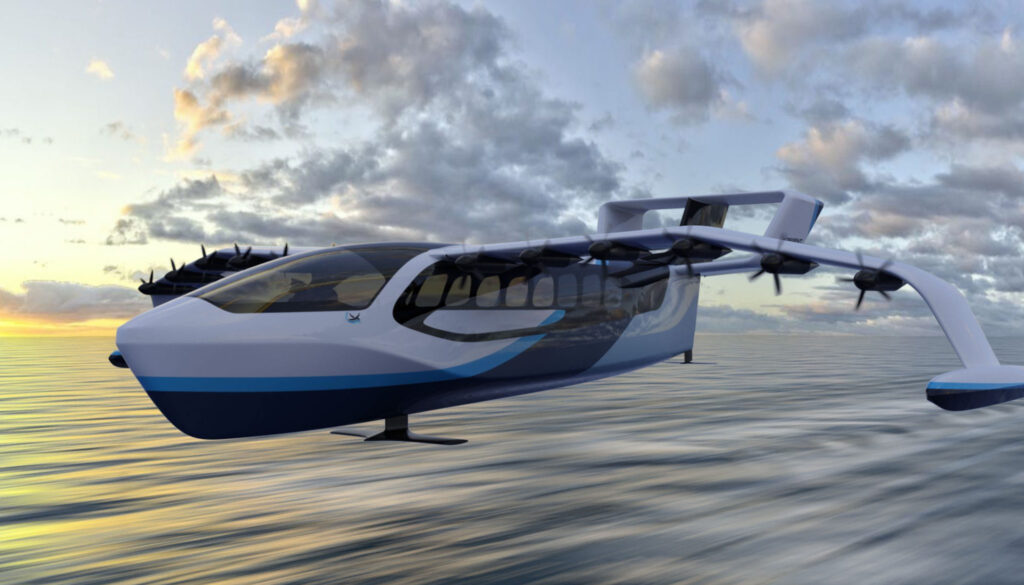Sail cargo becomes air cargo
Boston-based Regent Craft is launching a so-called seaglider, an all-electric flying boat that uses the ‘wing-in-ground’ effect just above the water: a cushion of air that boosts lift.
The REGENT Viceroy is a newly developed electric-powered wing-in-ground-effect flying boat being developed by Rhode Island-based REGENT Craft Inc, (REGENT is capitalised because it is an acronym, which stands for “Regional Electric Ground Effect Nautical Transport”). It will carry 12 passengers on flights of up to 290 km over coastal waters, using retractable hydrofoils during take-off. It plans to conduct test flights in 2024 and begin deliveries to customers in 2025. A 1/4-scale model was successfully demonstrated in Narragansett Bay in 2022.
First, Regent Craft will launch a 12-passenger version, the Viceroy, in 2025, followed later by the Monarch with a capacity of 100 passengers. With the Viceroy, Regent plans to conduct test flights this year. The company claims to have already received 600 orders. It has partnered with the UK classification society Lloyds Register to achieve certification in the short term.
“This is the next big step in the history of human transport,” says Billy Thalheimer, CEO and co-founder of REGENT. “There hasn’t been a new mode of transport since the helicopter. Gliders will bring welcome relief to travellers seeking an alternative to traditional air travel, serving coastal communities such as New York City, the Hawaiian Islands, Barcelona, Tokyo and many more worldwide. 40% of the world’s population lives in coastal communities These successful flights give us full confidence in our ability to widely adopt this technology and conduct commercial glider flights worldwide by 2025.”
Flyboats
The first 25 Viceroys and Monarchs have been bought by New Zealand company Ocean Glider, which entered into a contract worth $700 million with Regent Craft. The deal is backed by Monte, funder of start-ups, which provided $175 million. Monte Maritime further struck a deal with Craft Regent to buy some of the seaplanes for its leasing fleet for $300 million. Ocean Glider expects to offer a one-way flight between Wellington and Christchurch, a distance of 300 kilometres as the crow flies, for $60 from 2025. The flight takes over an hour. By car, the 440-kilometre journey, including the ferry between the north and south islands, takes over eight hours. Ocean Glider aims to keep prices low by running the flying boats at a high frequency.
According to Regent Craft, there are orders for a total of 600 units of the two types. The order book is said to be worth $6 billion.
In Germany, Regent is in talks with Förde Reederei Seetechnik (FRS), which operates ferry services between several islands. A letter of intent has already been signed with France’s Brittany Ferries to launch a seaplane in 2028. Further collaborations include Dubai and Hawaii and the Philippines while investors include Lockheed Martin and Japan Airlines. Abu Dabi wants to establish a network along the coast and deploy the seaplanes offshore.
Three modes
The REGENT glider flies low (within one wing span) over the water to take advantage of greater aerodynamic efficiency, allowing for greater payload and range than other electric aircraft concepts. The glider operates in three modes: from the dock, the vehicle first travels on its hull like a traditional boat. As it leaves the dock and speeds up, it rises on a hydrofoil. The hydrofoil provides significant wave tolerance and a smooth ride as the seaglider leaves a busy port. Upon reaching open water, the glider flies, retracts the hydrofoil and accelerates to cruising speed – all while staying within a span of the water’s surface. Controlling a glider is made possible by coupling advanced digital flight software with simple boat control.
The Viceroy, 19.80 metres wide and 17.50 metres long, is powered by 12 engines of 120 kW each. The brand of the motors is not yet known, as is that of the battery pack. Fully loaded, the aircraft weighs 6985 kilos.
Cargo version
The next step is the introduction of the Monarch, suitable for 100 passengers. According to Lloyds Register CEO Mark Darley, ‘sea planes’ can make an important contribution to emission-free passenger transport in coastal waters. The vehicle couples the higher speed of a small aircraft with the lower operating costs of a vessel. In addition to the passenger version, Regent will also develop a cargo version to thereby make the transport of goods between port cities faster and cheaper. The design is ready for the Viceroy Cargo with a payload of 1,600 kilos.
Regulations and certification
Lloyds Register will partner with the Coast Guard in the US, with which the Boston-based company is already in talks on drafting rules. In parallel, Lloyds Register is working on global certification. Included in this will be the ‘fly by wire’ fully automatic control system that will allow the number of levers, buttons and gauges in the cockpit to be reduced. German company Siemens is involved in the development of the automatic control system and further electrical installation.
Read more about this topic in an article by Willem de Niet in the Schuttevaer (Dutch, subscribers only).
Photo: The 12-seater Viceroy flying boat hovers low over the water. (©Renders Regent Craft)


